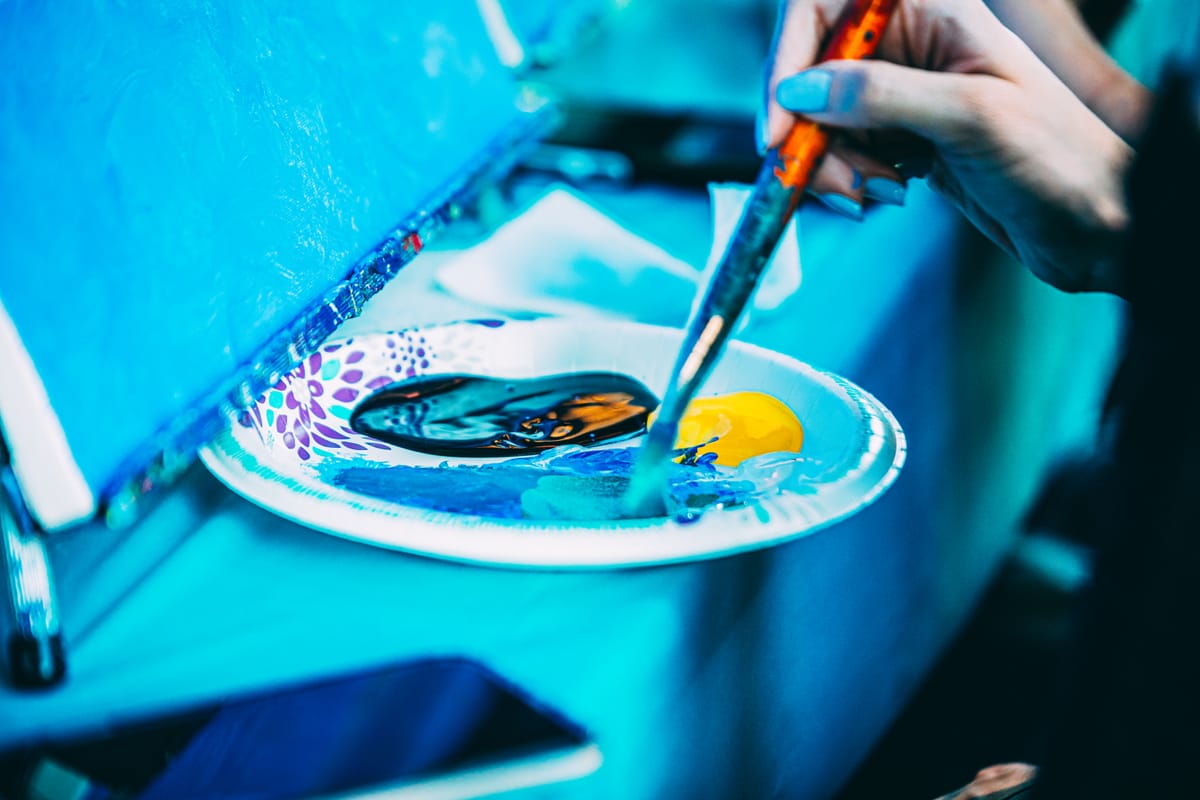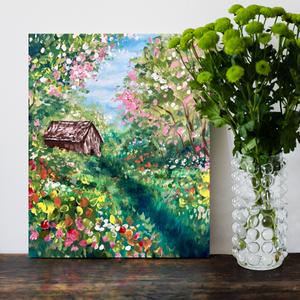Ready to dive into the exciting world of acrylic painting but unsure where to begin? Fear not! The original Paint Nite is here to help you out.
We've rounded up some super easy yet cool acrylic painting ideas to help jumpstart your creative journey and get those juices flowing. Whether you're into landscapes, abstract art, or something in between, we've got you covered.
So gather your paintbrushes, set up your canvas, and let's start painting your masterpiece!
What is Acrylic Painting?
Acrylic painting is a type of painting that uses water-based paint called acrylics. These paints are made from a mix of pigment and acrylic polymer emulsion, making them dry quickly and water-resistant when set.
But that's not all! Acrylic paints are also incredibly versatile and can be used on all kinds of surfaces like canvas, paper, wood, metal, and plastic. And, if you want to take your creativity to the next level, you can even mix them with different mediums (e.g., baking soda or silica sand) to create unique textures and effects.
That's why acrylic painting has become the go-to for artists of all levels—whether beginners or experienced artists. It's super easy to get started, accessible to everyone and allows you to experiment and create something truly unique.

Types of Acrylic Painting
As we say, these paints are extremely versatile. You can stick with traditional canvas painting, experiment with acrylic pouring (aka puddle painting), add a thinning agent and use them like watercolor paints, use palette knives instead of brushes, play with dot painting and much more.
Benefits of Acrylic Painting
Overall, acrylic painting is convenient and durable and offers many benefits.
For example, it is…
- Fast-drying
- Water-resistant (once dry)
- Easy to clean
- Non-toxic (unlike oil paints, which require harsh solvents for cleanup)
- Long-lasting & has excellent color retention
- Cost-effective
But that’s not all. There are tons of health benefits, too, for both the body and the mind…
- Reduces stress
- Improves fine motor skills
- Boosts self-esteem
- Provides a sense of community
Easy Acrylic Painting Ideas for Beginners on Canvas
OK, you now know a little more about what you’re working with. So how about those easy acrylic painting ideas?
In a nutshell, we recommend sticking to larger objects where you can be more carefree with your brush strokes.
We know it’s tempting to jump into complex paintings with tons of shades and intricate patterns. But it's important to walk before you run.
Stick to a simple color palette and select paintings that allow you to practice basic mixing, blending, and other painting techniques (basically any of our designs). With a bit of practice, you'll be ready to take on more complex paintings in no time!
Just remember, painting skills don’t happen overnight, so be patient and give yourself grace.
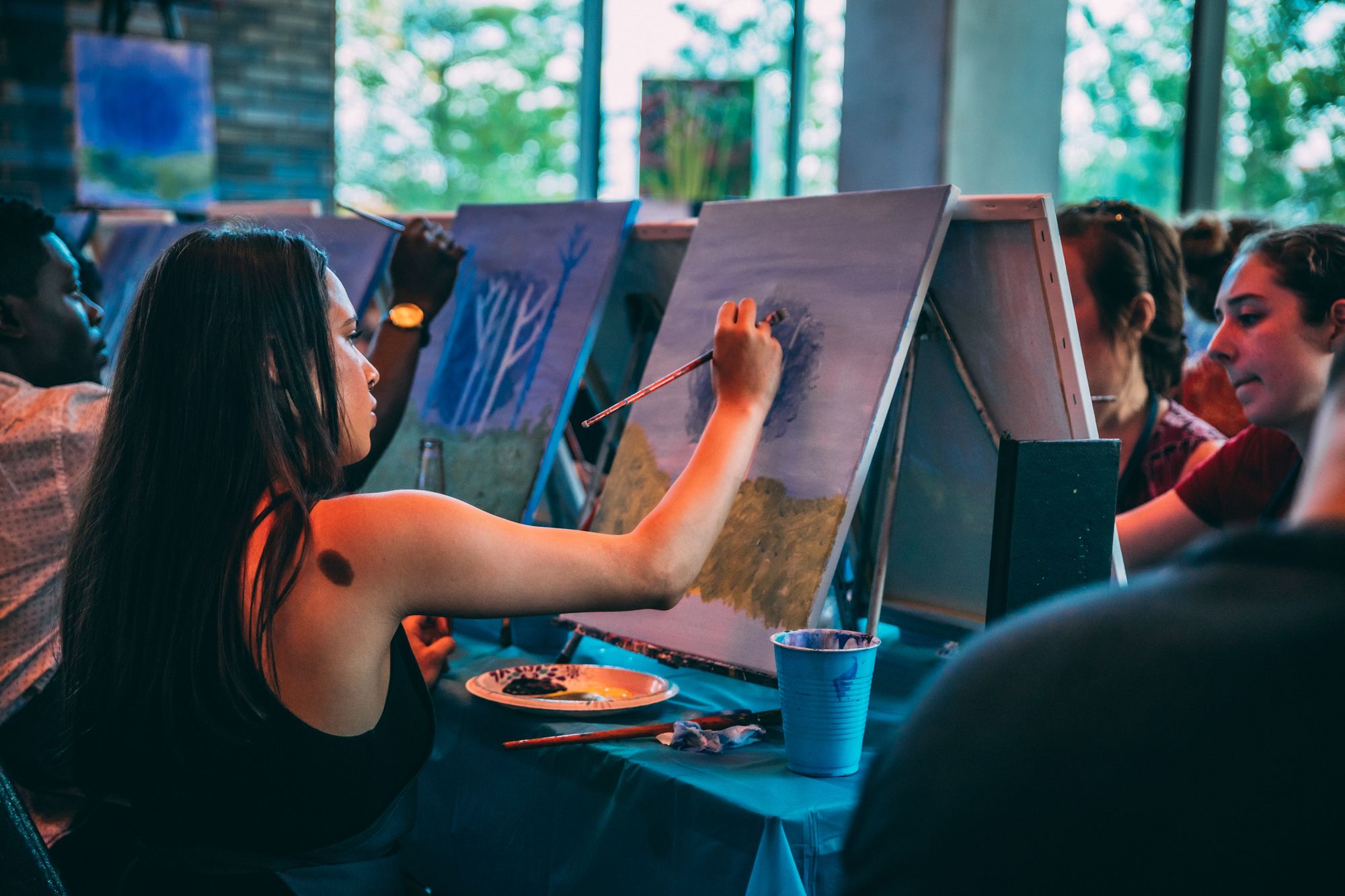
Abstract Art
Abstract art is the perfect acrylic painting idea for beginners. Let us tell you why:
Anyone can do it
Abstract painting is one of the most accessible forms of artwork for beginners. All you need is some paint, a canvas, and a willingness to let your imagination run wild.
No need to worry about getting it "right"
With abstract designs, you can let your creativity run wild without the pressure of creating a realistic image.
Let your creativity soar
This style is all about freedom of expression. It's a great way to explore your unique style and create something one-of-a-kind.
Mistakes are A-OK!
Abstract painting is incredibly forgiving. Any mistakes you make can easily be painted over or made to look intentional.
Check out these abstract acrylic painting ideas from PaintNite.com’s on-demand events catalog.
Abstract sip and paint night ideas
Floral Artwork
Whether you paint roses or sunflowers, flowers are a fun and easy way to get started, and you’ll never run out of options.
Inspiration is everywhere
Flowers are all around us, which makes them an abundant source of inspiration for your art. You can find them in your garden, at the park, or even at the local florist shop!
Simple shapes and a wide range of colors
Flowers have simple shapes and forms, so they’re an excellent subject for beginners. With their variety of vibrant colors, there’s plenty of room for experimentation so you can create some real, eye-catching art.
Provides a sense of calm
Lastly, working with flowers can be calming and relaxing, allowing you to de-stress and unwind while creating something beautiful.
Check out these acrylic painting ideas for beginners, also from our on-demand library.
Floral sip and paint night paintings
Painting Landscapes
If you're new to canvas painting, landscapes are a great subject matter. Here's why:
Practice many techniques
Landscapes are excellent for learning and practicing various painting techniques, such as blending, creating depth, and adding texture. Plus, they often feature simple shapes and forms.
Develop your observation skills
Landscapes require you to closely observe the natural world around you, paying attention to details like light and shadow, color, and perspective. This can develop your artistic eye and improve your ability to recreate what you see on the canvas.
Endless possibilities for creativity and self-expression
You can paint a realistic landscape or add your own spin and create an abstract or impressionistic version. You can also experiment with color palettes to create a unique mood or atmosphere.
Calming and therapeutic
Escape the stress of everyday life and get lost in the beauty of nature. You can paint trees, a night sky, the beach…whatever scenes you enjoy in real life.
Landscape paintings from PaintNite.com
Still Life Paintings
As the name suggests, still lives feature objects that don't move, like a vase of flowers or a bowl of fruit.
Focus on the basics
You don't have to worry about capturing movement or emotions like you would with a person or animal. Instead, you can really focus on the basics, like color, shape, form, light and shadow, and texture.
Control over the environment
You can take your time arranging your objects however you like so you feel comfortable and confident as you paint.
Still life painting ideas from PaintNite.com
Painting Animals
Animals have a lot of different textures and patterns in their fur or skin, which can help you learn to create all kinds of strokes with your brush. Plus, animals come in all sorts of shapes and sizes, so you can experiment with various compositions and figure out what looks good to you.
The cuteness factor is a huge selling point too!
Animal sip and paint night ideas
Where and How to Learn Acrylic Painting
There’s no right or wrong way when it comes to canvas painting. However, getting help in the early stages will undoubtedly boost your confidence so you can go on to do those amazing paintings you dream about.
PaintNite.com has three ways you can learn to paint with us: in-person, virtually (with a live host) or on-demand (pre-recorded acrylic painting tutorials). Whichever option you pick, you’ll see our hosts have a unique talent for making the process seem extremely easy.
In-Person Painting Class
Explore paint and sip events near you and get step-by-step acrylic painting instructions for an entire canvas—perfect for beginners. Most paintings in our library are suitable for those just starting out, so go for whichever you like best!
You’ll discover galaxy paintings, some for the holiday season, plenty of landscapes (in the day or with a starry night sky), flowers and many more ideas.
You may even find events where we paint different surfaces, such as wine bottles, not just canvas painting!
These events are about socializing as much as anything else. So bring your posse, speak to the other guests and feel free to ask questions.
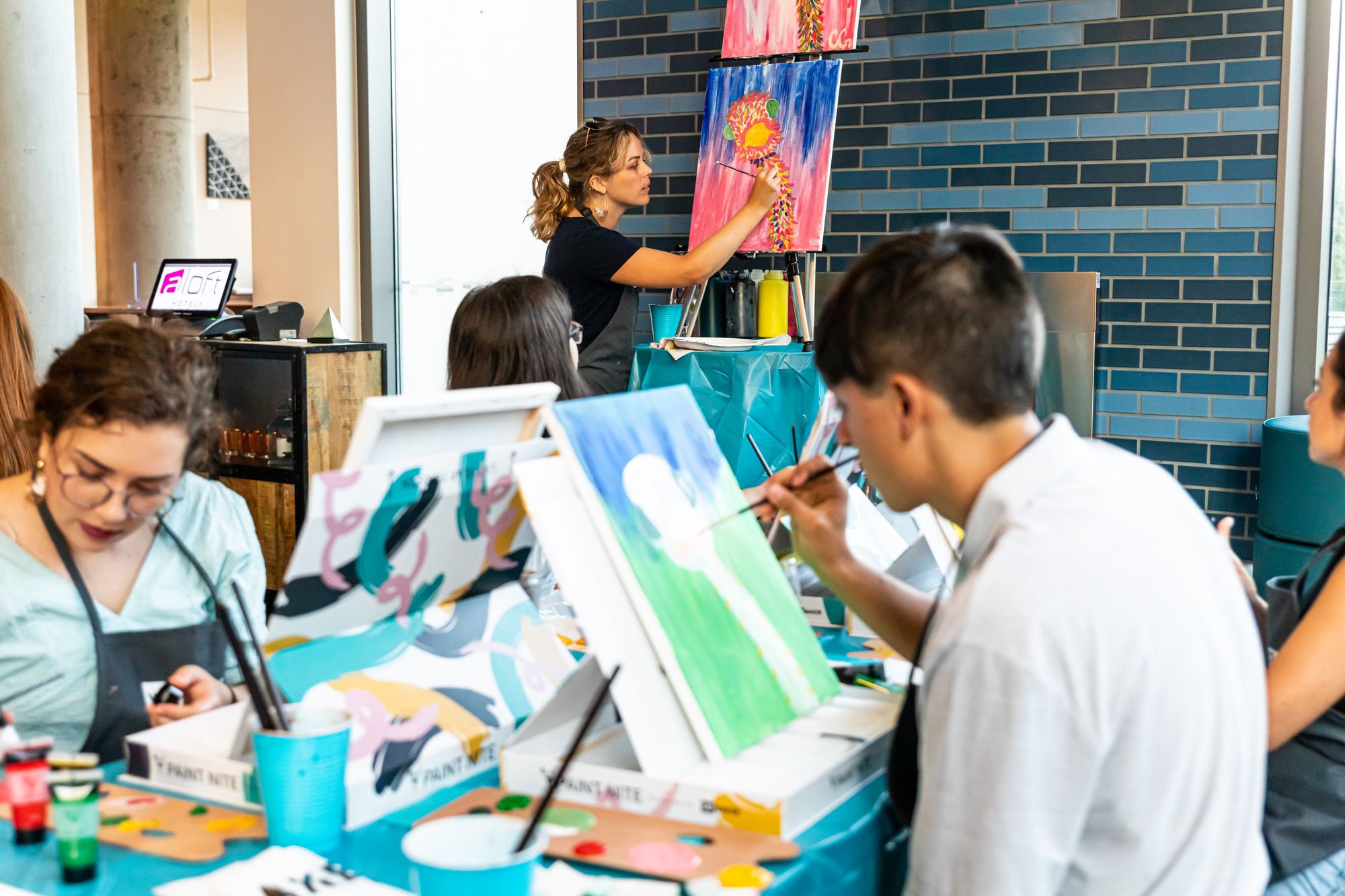
Online Painting: Virtual Paint Nite
If you’re more of a home bird or don’t currently have Paint Nites near you, you’ll love our virtual events! You’ll still learn how to create a great painting with the help of a pro who will answer any questions, but you can do it all without leaving the house.
Once you feel more confident and want to advance your acrylic painting techniques, look for a series on our calendar to help with detailed work.
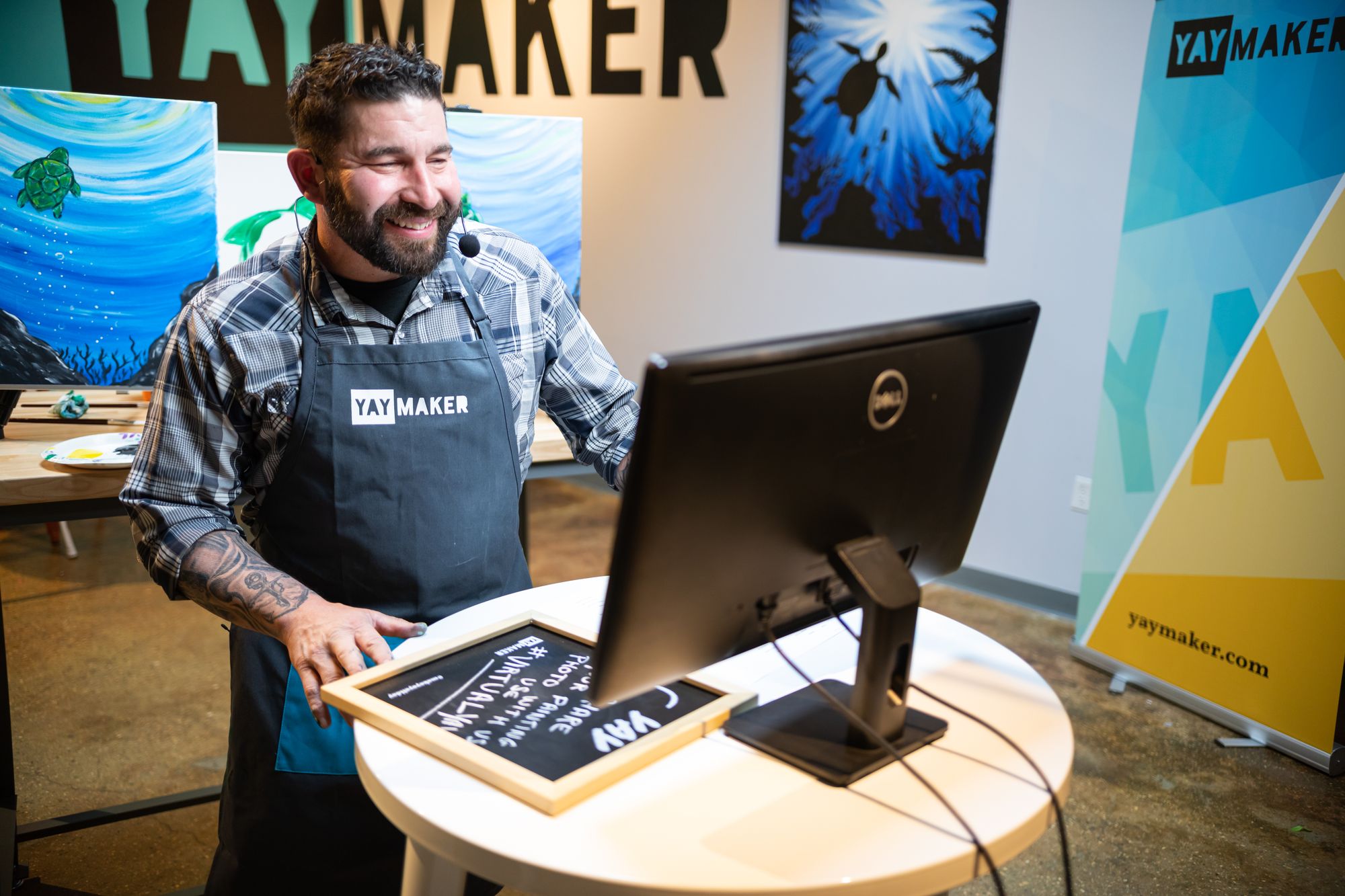
Online Painting: Events On-Demand.
Our on-demand catalog has endless acrylic painting ideas (over 400 and counting)! You can enjoy all of the above and many, many more.
With these events, you get a pre-recorded video tutorial, which you can pause, rewind, and come back to over seven days.
Why choose these and not a YouTube tutorial? You can see the same Paint Nite faces you know and love, along with their dynamic personalities. Plus, you’re supporting our network of local artists whose livelihoods depend on these events.
Acrylic Painting FAQs
What exactly are acrylic paints?
Acrylic paints are water-based paint made from pigment and acrylic polymer emulsion. They're known for drying quickly, being water-resistant once dry, and their versatility.
What materials do I need to get started with acrylic painting?
Basic supplies you'll need include:
- Acrylic paint (primary colors, white and black paint minimum)
- A variety of paintbrushes
- A surface to paint on (such as canvas or paper)
- Water
- A palette/paper plate to mix your paints on
How do I select the right brushes for acrylic painting?
Choose brushes with synthetic bristles, as acrylic paint can damage natural ones. The size and shape of the brush will depend on the details and techniques you plan to use in your painting.
What surfaces are suitable for acrylics?
You can use acrylics on a variety of surfaces, including canvas, paper, wood, metal, and plastic. However, preparing the surface before painting is crucial to ensure the paint adheres properly.
How do I mix colors with acrylic paints?
You can mix acrylic paints on a palette using a palette knife or a brush. Mixing the colors thoroughly to achieve the desired hue and consistency is essential.
Do you wet the brush before using acrylic paint?
You don’t need to wet your brush, but acrylic paints are water-based, so adding water to your brush can help to thin the paint and make it easier to spread on your canvas or surface. It also helps with blending later on.
Just try not to make the paint too watery, as this can affect the color intensity and may cause the paint to run or drip. Experiment with different amounts of water to achieve the desired consistency for your painting technique.
How do I clean my brushes after painting with acrylics?
Clean your brushes with water immediately after use to prevent the paint from drying on the bristles. If the paint has dried, soak the brush in water and use soap or brush cleaner to remove the paint.
How long does it take for acrylic paint to dry?
Acrylic paint dries quickly, usually within 15-30 minutes. However, the drying time can vary depending on the thickness of the paint, humidity and temperature of the environment.
How can I add texture to my acrylic paintings?
You can add texture to your acrylic paintings using a palette knife or mixing a texture medium with your paint. You can also use different types of brushes or experiment with layering and blending techniques to create texture.
How can I create depth in my acrylic paintings?
To create depth in your acrylic paintings, use lighter colors in the background and gradually add darker shades in the foreground. You can also use perspective and shading techniques to create the illusion of depth.
How do I varnish my acrylic painting?
Allow your painting to dry completely before applying varnish. Use a brush to apply the varnish in thin, even coats, allowing each coat to dry completely before applying the next. You can choose a glossy, matte, or satin finish for your varnish.
Conclusion
In conclusion, acrylic painting is a versatile and accessible medium with many benefits.
Whether you're a newbie or an experienced artist, there are endless possibilities for creativity and self-expression. From abstract designs to floral artwork, landscape paintings, and still life paintings, there are plenty of easy acrylic painting ideas to choose from to kickstart your artistic journey.
So grab your paintbrushes, set up your canvas, and let your imagination run wild!
Find all your painting ideas and inspiration here from PaintNite.com's talented local artists.

